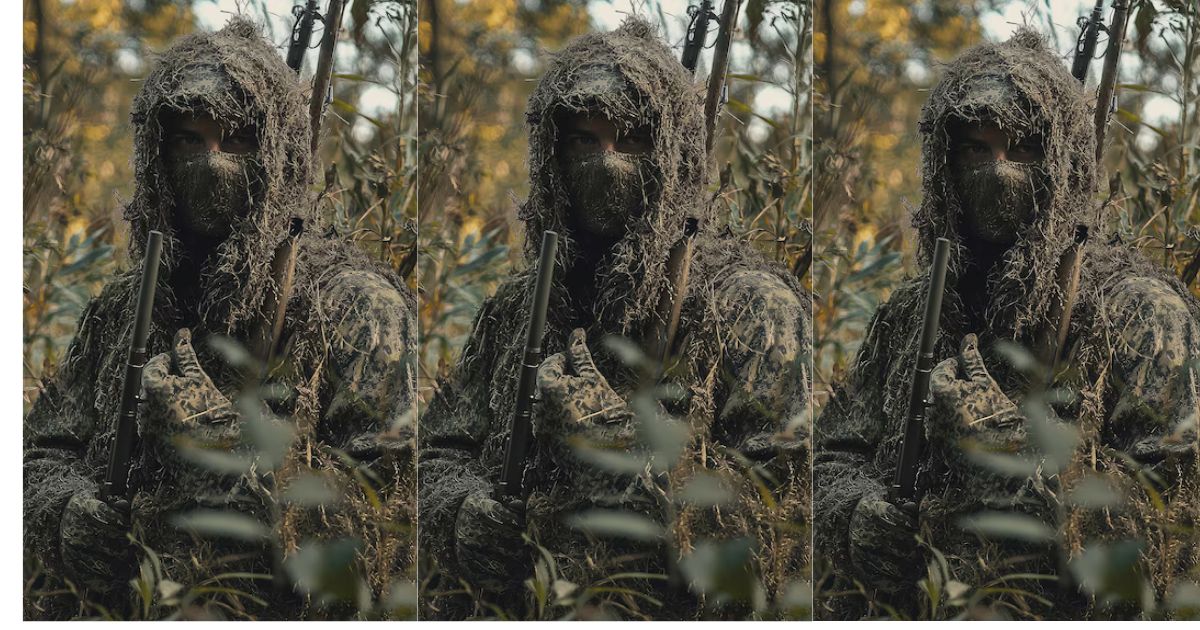The ghillie suit is not just any type of clothing; it’s a highly effective camouflage tool designed to help you blend seamlessly into natural surroundings. Whether you’re a military professional, a hunter, or even a photographer, this suit can be your ultimate partner in staying hidden from sight. With its intricate design, made from a combination of fabric and natural materials, it mimics the surrounding environment, making the wearer virtually invisible. But how exactly does this suit work, and why is it so popular? Let’s dive deeper into what makes the ghillie suit such an essential piece of camouflage gear.
History of the Ghillie Suit
The origins of the ghillie suit trace back to the Scottish Highlands, where gamekeepers, called “ghillies,” would wear these suits to blend in with the environment and watch over the game undetected. Over time, the military recognized its potential for concealment and adopted it for snipers, making it a key element in modern warfare. The suit’s evolution has led to more advanced and specialized designs for different terrains, from forests to deserts.
What is a Ghillie Suit Made Of
A typical ghillie suit is crafted from a base layer, often a lightweight material like mesh or cotton, to allow ventilation. The key to its effectiveness lies in the attached strips of burlap, twine, or synthetic fibers that mimic natural elements such as grass, leaves, and twigs. These materials are dyed in various shades to match the surrounding terrain, and some users even attach real foliage for added realism.
How Does a Ghillie Suit Work
The ghillie suit’s effectiveness lies in its ability to break up the human silhouette. By mimicking the textures, colors, and patterns of the environment, it makes it extremely difficult for others to distinguish the wearer from their surroundings. This is particularly crucial for hunters and snipers, as being detected could lead to failure in their missions.
Types of Ghillie Suits
While all ghillie suits serve the same basic function of camouflage, different types exist for different environments and purposes.
Woodland Ghillie Suits
These suits are designed for forested or grassy environments. They usually feature a combination of green, brown, and black tones to mimic trees, bushes, and underbrush.
Desert Ghillie Suits
For arid and sandy environments, desert ghillie suits incorporate lighter colors like tan, beige, and muted yellow. These suits are perfect for military operations or hunting in desert areas.
Snow Ghillie Suits
Hunters and military personnel use these suits to remain undetected in cold, snowy environments.
Benefits of Using a Ghillie Suit
1. Stealth in Hunting
For hunters, staying hidden is critical for success. A ghillie suit allows them to get closer to their target without being noticed, increasing their chances of making a successful shot.
2. Military Applications
Snipers and reconnaissance personnel in the military rely on ghillie suits to stay concealed during missions. By blending into their surroundings, they can observe enemy movements and take action without being detected.
3. Wildlife Photography
Wildlife photographers also benefit from using a ghillie suit, as it allows them to approach animals closely without alarming them. This results in better, more natural shots.
How to Choose the Right Ghillie Suit
Choosing the right ghillie suit depends on the environment and purpose for which you intend to use it. Key factors to consider include:
1. Terrain Compatibility
Ensure that the suit’s colors and materials match the environment you’ll be using it in. A woodland suit won’t be effective in the desert, just as a snow ghillie suit won’t help in a forest.
2. Weight and Comfort
The weight of a ghillie suit can be a critical factor, especially for long missions or hikes. Some suits are bulkier due to the materials used, while others are lightweight and breathable, making them ideal for long-term wear.
3. Durability
If you’ll be using your ghillie suit in rough terrains, it’s essential to pick one that’s durable and can withstand wear and tear. High-quality suits use robust fabrics and construction techniques that prevent them from falling apart after minimal use.
How to Maintain a Ghi’llie Suit
Maintaining a ghi’llie suit is crucial to prolong its effectiveness and lifespan.
Cleaning
Avoid machine washing, as this can damage the delicate fibers and attachments. After washing, hang the suit to dry in a well-ventilated area.
Repairs
Over time, the natural and synthetic fibers in a ghillie suit can come loose or tear. Regularly inspect your suit for damage and patch it up using fabric glue or stitching to ensure it remains functional.
DIY Ghi’llie Suit: How to Make Your Own
Many enthusiasts prefer to make their own ghillie suits, as it allows for more customization and can be more cost-effective. Here’s a basic guide to creating your own ghillie suit:
Materials Needed
Mesh or light fabric base (preferably in a neutral color)
Burlap or jute twine (in various natural shades)
Fabric dye
Needle and thread or fabric glue
Steps to Make a Ghi’llie Suit
Start by cutting strips of burlap or jute in different lengths and colors.
Attach these strips to your mesh base by sewing or gluing them.
Finally, add real foliage or materials from your surroundings to blend even better with the environment.
Common Mistakes When Using a Ghillie Suit
Using a ghillie suit effectively requires more than just wearing it. Here are some common mistakes to avoid:
Incorrect Suit for Terrain
Wearing a desert ghillie suit in a forest will make you stand out rather than blend in. Always match your suit to the environment.
Poor Movement Control
Even when wearing a ghi’llie suit, sudden movements can give away your position. Slow, deliberate movements are key to maintaining camouflage.
Conclusion
The ghi’llie suit is a game-changer in the world of camouflage. Whether you’re hunting, on a military mission, or photographing wildlife, the right suit can make all the difference. From choosing the right type for your environment to maintaining it and avoiding common mistakes, this guide has covered everything you need to know about ghillie suits.
FAQs
Can a ghi’llie suit be used in any environment
No, different environments require different types of ghillie suits. For example, woodland suits are not effective in desert or snowy conditions.
Are ghi’llie suits comfortable to wear for long periods
This depends on the suit’s weight and materials. Some are lightweight and breathable, while others can be bulky.
How do I wash a ghi’llie suit
Hand wash with mild soap and water. Avoid machine washing, as it can damage the fibers and attachments.
Can I make my own ghi’llie suit
Yes, you can make a DIY ghillie suit with basic materials like burlap, jute, and a mesh base.
What is the history of the ghi’llie suit
The ghillie suit originated in Scotland, where it was used by gamekeepers to blend into the environment while observing wildlife.











